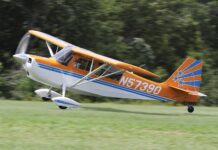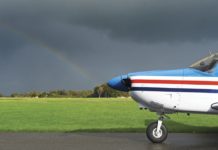
By Jeff Pardo
Did you know that flying at maneuvering speed when encountering turbulence might not be such a good idea? Wait a minute, you may have said to yourself. I know that flying above maneuvering speed when penetrating turbulence can definitely be non-habit forming, so…since when should I not slow down when things get bumpy? Dont worry; I havent been sniffing too many fuel samples. All I mean to say is that even maneuvering speed might be too fast.
Maneuvering speed, of course, is that weight-related speed not marked on your airspeed indicator below which full and abrupt control deflection is not supposed to result in airframe failure. Its commonly used as a turbulence penetration speed, as well as a yardstick for all of those proficiency maneuvers were urged to practice and which we need to demonstrate on the Commercial and Flight Instructor practical tests.
But maneuvering speed, or Va, isnt always the best speed to use in turbulence, especially if we want the wings to stay attached. In fact, it can be too fast. In the end, its less a matter of whether were in turbulence than it is the quality of that turbulence.
High vs. Low
This may sound peculiar, but in addition to airspeed considerations, we must also deal with the other half of the equation: the airs speed. More specifically, were usually concerned with how fast the air is moving and with its predictability. When considering these variables, we also need to consider the pronounced influence of altitude on the likelihood of encountering turbulence.
Usually, altitude is our friend. A number of benefits can accrue from taking the high road. They include: less traffic and more direct routings, vastly increased options for safe havens in an emergency, better radio communications, higher true airspeeds and more miles per gallon, the near impossibility of getting lost, very much lower odds of a bird strike, plus cooler temperatures and better visibility above haze layers, especially in the summer. And altitude generally brings with it smoother air, except in the flight levels where we can encounter clear air turbulence. On the other hand, you can also find ferocious headwinds and icing up there; if its not howling at you from the front, its usually shoving you sideways.
On the coins other side, flying down low has its good points, as well, although fewer of them. Aside from your progress over the ground being more apparent and always having a close-up look at your potential emergency landing sites-yes, Im reaching here-unfavorable winds are less unfavorable down in the friction layer. Flying higher wont keep you out of frontal or convection-induced turbulence, but orographic (terrain-induced) turbulence can be less severe. When low-level winds flow over and around even small hills (and buildings), potentially dangerous downstream vortices can result, even at altitudes several times that of the geography (or structure) that spawned them.
Other weather phenomena, like fast-moving winter cold fronts, can generate some very severe, rip-snorting rides down low. Especially at lower altitudes, the thermals sailplane pilots seek and which result from differential solar heating can be the cause of a bumpy ride. Punching through an invisible forest of them in a powered airplane can be misery; for the glider pilot, its ecstasy.
Too, one encounters wind shear near the top of haze layers or the upper boundaries of stratus clouds when flying through temperature inversions. The biggest inversion of all, of course, involves flying up towards or into an advancing warm front, bringing with it the possibility of shear-related turbulence, plus icing or, possibly much worse, freezing rain when precipitation falls into the colder air below.
When flying near the boundaries of earth and water, the result of differential heating such as land and sea breezes are like miniature fronts, with the same-although usually reduced-potential for bumps. Upper-level troughs affect the air below, and surface lows can be strengthened by their upper-level counterparts, even more so than you might guess from looking at a low-level chart: When there is only the most gradual of wind gradients from high to lower altitudes, staying on the glideslope can be more difficult.This is because winds can decrease at lower altitudes faster than we can account for them.
And we cant forget the mother of all turbulence-avoidance strategies: staying well clear of convective activity, either en route or (especially with regard to gust fronts and microbursts) when near the ground.
The purpose of all this isnt a point-counterpoint essay about the relative merits of flying high or buzzing along down low. But whichever road you take, youre going to be flying low soon after you take off, and again just before you land, and this just happens to comprise the most risky phase of almost any flight you will make. And in the grand scheme of things, we usually encounter roiling air more often at lower altitudes, which might be where we can least afford it.
Weight, Age and Speed
Now we come to the means of self-preservation I first mentioned: slowing down. This mitigating measure is actually one of the simplest but possibly most important, especially during your descent from cruise altitude. (Yes, I realize that descending and slowing down at the same time might seem to be mutually exclusive, despite what ATC wants from time to time. Deal with it.)
The main point about this otherwise intuitively obvious thing called maneuvering speed, which however is not so intuitively obvious, is that the most important thing is actually to fly slower than maneuvering speed or your estimate of what it should be, based upon your airplanes approximate weight at the time. (Why? Youll see.)
Another consideration is age: If your airplane is pushing 30 (years, that is), it may have just one published Va speed. Since maneuvering speed is directly related to the square root of an airplanes gross weight, it decreases in proportion to any decrease in weight below maximum gross weight.For many airplanes, a gross-weight maneuvering speed may be all there is in the POH: Its up to the pilot to compute a new weight-based Va, depending on how the airplane is loaded and how much fuel is aboard.
A vs. B
But besides overstressing the airframe while reacting to the turbulence, theres another consideration: what the gusts can do to your aircraft before you have a chance to react. To measure this, theres actually another V-speed, one known as Vb, or gust-penetration speed, which aircraft manufacturers assess in regard to sudden sharp changes in wind speed and direction.
By definition, the control surfaces are not fully deflected when computing Vb-the pilot presumably hasnt had time to react-however, the result is similar: increased load factor (although the stresses may be less). The current requirements, as stated in FAR 23.333, are for vertical-gust tolerances of 50 fps up to an altitude of 20,000 feet, equating to about 30 knots, down to 25 fps at 50,000 feet. To provide a rough yardstick, Britains Royal Air Force did a study that said airspeed fluctuations greater than 25 knots constitute severe turbulence.
In general, recommended gust penetration airspeeds are lower than maneuvering speeds (although if you find Vb values in your POH, youre lucky). Maneuvering speed is obtained by multiplying the power-off stall speed by the square root of the limiting positive design load factor (3.8 g, for normal category airplanes, giving 1.95 times Vs). However, we usually fly (or so we would expect) with the power on, and the power-on stall speed is significantly less than when the power is off. When the stall speed decreases, maneuvering speed decreases with it.
If a pilot encounters turbulence subjecting the airplane to a gust from the front, this would have the effect of increasing the airspeed beyond the value of maneuvering speed. The closest approximation Ive seen for Vb is 1.7 times the clean power-off stall speed at maximum gross weight. This approximate number would be good at all weight conditions. Of course, if your POH a Vb value, use that instead!
By the way, slowing down is good, but throttling back to a veritable crawl could actually be hazardous: You want to keep positive control responses, and you dont want to inadvertently stall, especially close to the ground.
So, if you know (or suspect) that bumpy air may be on the program, the one thing you must not do is let airspeed go above Vno, the top of the green arc on your airspeed indicator. (I know: well, duh.)
The first thing that probably would have occurred to you right off the bat is to make an immediate power reduction-start one quickly that is, but do it gradually (unless you happen to be flying a turbine) and let airspeed decay while still in level flight. Then when it gets below Vfe or Vle, you respectively can lower the flaps or landing gear, if so equipped. That will slow you down more, of course. If your airplane has spoilers or speed brakes, you have more options than I usually do. The whole point of this is to attain slow, stable flight in a descent, before you hit the bumps.
Putting It All Together
I happen to enjoy aerobatic flight, but I do harbor some distaste for and distrust of flight in turbulence. If youve read this far, you understand many of the reasons for my disdain of turbulence. If you encounter unexpected turbulence, grit your teeth and know youre doing the best you can. Focus on your target airspeed and on keeping the wings more or less level.
Dont add maneuvering loads to the gust loads by horsing the controls around in immediate retaliation to each separate upset. Forget about holding altitude. Use small corrections for those inevitable attitude excursions-large control surface movements just invite pilot-induced oscillations or, worse, excessive speeds and large attitude excursions. Inform ATC of the reason for your duress, and if they ask for anything expedited, use the U word (as in unable). And forget the autopilot!
Also With This Article
“Gusts And G-Loading”
“Do You Fly An Older Airplane?”
“Low-Level Bumps”
“Finding Turbulence”
“How Bumpy Is It?”
-Jeff Pardo is a freelance writer and editor who holds a Commercial certificate for airplanes, helicopters and sailplanes.




It is very disappointing to see an article republished with the same error that was pointed out in 2006 – See Unicom in August 2006 issue. A dangerous mistake (acknowledged by yourselves) has been repeated a second time.